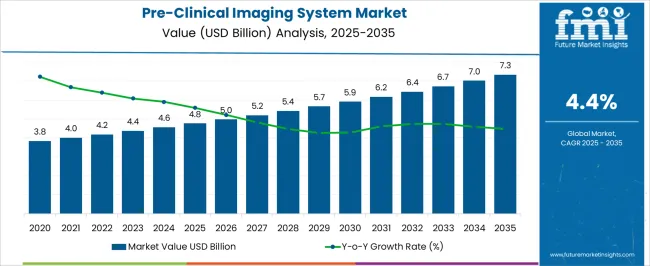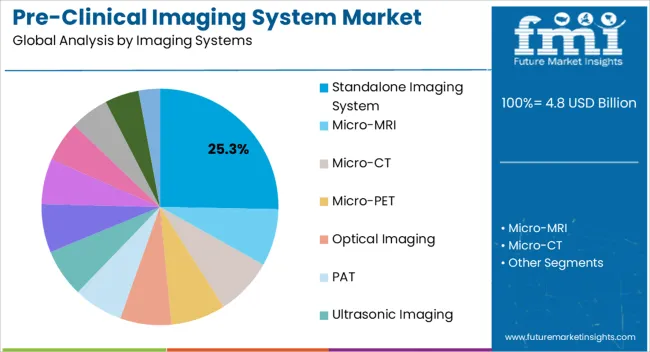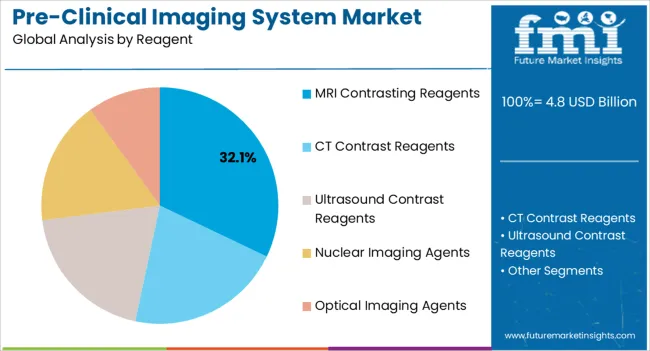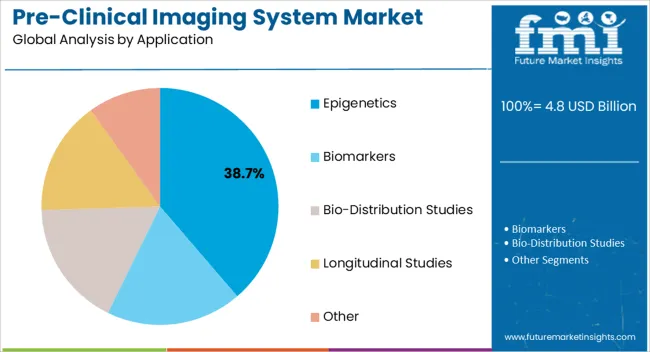The Pre-Clinical Imaging System Market is estimated to be valued at USD 4.8 billion in 2025 and is projected to reach USD 7.3 billion by 2035, registering a compound annual growth rate (CAGR) of 4.4% over the forecast period.

| Metric | Value |
|---|---|
| Pre-Clinical Imaging System Market Estimated Value in (2025 E) | USD 4.8 billion |
| Pre-Clinical Imaging System Market Forecast Value in (2035 F) | USD 7.3 billion |
| Forecast CAGR (2025 to 2035) | 4.4% |
The Pre-Clinical Imaging System market is experiencing steady growth, driven by the increasing demand for advanced imaging technologies in research, drug discovery, and molecular biology studies. Rising investments in pre-clinical research, particularly in the fields of oncology, neurology, and regenerative medicine, are fueling adoption. Technological advancements in high-resolution imaging, automated data acquisition, and integration with analytical software are enhancing the accuracy and efficiency of pre-clinical studies.
The need for early-stage disease detection, mechanistic insights, and biomarker identification is creating a strong demand for sophisticated imaging systems and reagents. Growing emphasis on personalized medicine and precision therapeutics further supports market expansion, as researchers require reliable tools to evaluate treatment efficacy and biological responses.
Regulatory compliance for pre-clinical trials, along with the adoption of standardized protocols, is encouraging investments in high-performance imaging platforms As life sciences research continues to expand and pre-clinical studies become increasingly complex, the market is poised for sustained growth, with innovations in imaging hardware and reagent chemistry driving adoption across academic and industrial laboratories.
The pre-clinical imaging system market is segmented by imaging systems, reagent, application, end user, and geographic regions. By imaging systems, pre-clinical imaging system market is divided into Standalone Imaging System, Micro-MRI, Micro-CT, Micro-PET, Optical Imaging, PAT, Ultrasonic Imaging, Multimodal Imaging System, PET+SPECT+CT, SPECT+MRI, PET+MRI, PET+CT, and SPECT+CT. In terms of reagent, pre-clinical imaging system market is classified into MRI Contrasting Reagents, CT Contrast Reagents, Ultrasound Contrast Reagents, Nuclear Imaging Agents, and Optical Imaging Agents. Based on application, pre-clinical imaging system market is segmented into Epigenetics, Biomarkers, Bio-Distribution Studies, Longitudinal Studies, and Other. By end user, pre-clinical imaging system market is segmented into Clinical Research Organization (CRO), Pharmaceutical Industries, Biotechnology Industries, and Government And Private Research Institutes. Regionally, the pre-clinical imaging system industry is classified into North America, Latin America, Western Europe, Eastern Europe, Balkan & Baltic Countries, Russia & Belarus, Central Asia, East Asia, South Asia & Pacific, and the Middle East & Africa.

The standalone imaging system segment is projected to hold 25.3% of the market revenue in 2025, making it the leading imaging systems category. Its growth is being driven by the flexibility and ease of deployment that standalone systems offer for pre-clinical laboratories. These systems allow researchers to conduct imaging studies independently without the need for integration with larger imaging suites, which reduces setup complexity and enhances operational efficiency.
The high-resolution imaging capabilities, combined with precise data acquisition, support robust evaluation of biological models and experimental reproducibility. Additionally, standalone imaging systems are being preferred due to their adaptability across diverse research applications, including small animal studies and molecular imaging.
Continuous advancements in imaging hardware, such as improved detectors, optical systems, and software interfaces, have strengthened the reliability and accuracy of these platforms As pre-clinical studies continue to expand in scale and complexity, standalone imaging systems are expected to maintain their leadership, supported by their operational versatility, ease of use, and ability to deliver high-quality imaging results in varied research settings.

The MRI contrasting reagents segment is anticipated to account for 32.1% of the market revenue in 2025, making it the leading reagent category. Growth is being driven by the increasing need to enhance imaging contrast and sensitivity in pre-clinical studies, allowing researchers to visualize anatomical structures, cellular processes, and disease progression with higher precision. Advanced MRI contrasting reagents improve signal-to-noise ratio and tissue differentiation, which is critical for evaluating treatment responses and studying disease mechanisms.
These reagents are widely adopted in oncology, neurology, and cardiovascular research, where high-resolution imaging is required for accurate interpretation of experimental data. The development of novel, biocompatible, and targeted MRI reagents has further expanded applicability across diverse research models.
Integration with advanced imaging platforms and software tools enables real-time monitoring and quantitative analysis, enhancing experimental reproducibility As the demand for precise and reliable pre-clinical imaging grows, MRI contrasting reagents are expected to maintain their leading position, driven by technological innovation and the increasing adoption of MRI-based studies in drug development and translational research.

The epigenetics application segment is projected to hold 38.7% of the market revenue in 2025, establishing it as the leading application area. Growth in this segment is driven by the increasing focus on understanding gene regulation, chromatin modifications, and molecular mechanisms underlying disease. Pre-clinical imaging systems are being leveraged to study epigenetic changes in live models, enabling visualization of dynamic biological processes and cellular responses to therapeutic interventions.
High-resolution imaging combined with targeted molecular probes provides critical insights into gene expression patterns and epigenetic modifications, supporting drug discovery and biomarker identification. The growing investment in epigenetic research across academic institutions, biotechnology firms, and pharmaceutical companies has further accelerated adoption.
Integration of imaging data with bioinformatics and analytical platforms enhances experimental reproducibility and enables precise quantification of epigenetic changes As personalized medicine and precision therapeutics continue to expand, the epigenetics application segment is expected to remain the primary driver of market growth, supported by advanced imaging technologies and reagents that enable detailed molecular-level investigations.
Imaging Science is a developing field that effects different biomedical research area, for example, oncology, neurology, cardiology, immunology and infection diseases. Pre-clinical imaging systems helps in the monitoring and visualization of animals with respect to cells, tissues, organ, physiological changes and environmental changes taking place inside the animal body.
The utilization of small animal models in preclinical studies is a major cornerstone for research and development techniques also pre-clinical imaging technique is filling the gap between the discoveries at molecular level and clinical trials level. The imaging systems that are non-invasive and in vivo have become very important in research area.
The most suitable systems for small animal in vivo imaging application are based on nuclear imaging techniques, optical imaging, magnetic resonance imaging, ultrasound imaging and computed tomography. Growth of pre-clinical imaging system market is driven by recent advances in pre-clinical imaging system which includes, multi-modality imaging systems which combines more than one imaging principle for better results for example, PET+CT, SPECT+CT combined imaging systems.
Also, increased use of small animal research specific imaging systems like, Micro-CT, Micro-MRI, Micro-PET, Micro-SPECT etc. are increasing use of pre-clinical imaging systems in drug development studies, pre-phase-I studies and target identification studies.

| Country | CAGR |
|---|---|
| China | 5.9% |
| India | 5.5% |
| Germany | 5.1% |
| France | 4.6% |
| UK | 4.2% |
| USA | 3.7% |
| Brazil | 3.3% |
The Pre-Clinical Imaging System Market is expected to register a CAGR of 4.4% during the forecast period, exhibiting varied country level momentum. China leads with the highest CAGR of 5.9%, followed by India at 5.5%. Developed markets such as Germany, France, and the UK continue to expand steadily, while the USA is likely to grow at consistent rates. Brazil posts the lowest CAGR at 3.3%, yet still underscores a broadly positive trajectory for the global Pre-Clinical Imaging System Market. In 2024, Germany held a dominant revenue in the Western Europe market and is expected to grow with a CAGR of 5.1%. The USA Pre-Clinical Imaging System Market is estimated to be valued at USD 1.6 billion in 2025 and is anticipated to reach a valuation of USD 2.3 billion by 2035. Sales are projected to rise at a CAGR of 3.7% over the forecast period between 2025 and 2035. While Japan and South Korea markets are estimated to be valued at USD 256.8 million and USD 160.5 million respectively in 2025.

| Item | Value |
|---|---|
| Quantitative Units | USD 4.8 Billion |
| Imaging Systems | Standalone Imaging System, Micro-MRI, Micro-CT, Micro-PET, Optical Imaging, PAT, Ultrasonic Imaging, Multimodal Imaging System, PET+SPECT+CT, SPECT+MRI, PET+MRI, PET+CT, and SPECT+CT |
| Reagent | MRI Contrasting Reagents, CT Contrast Reagents, Ultrasound Contrast Reagents, Nuclear Imaging Agents, and Optical Imaging Agents |
| Application | Epigenetics, Biomarkers, Bio-Distribution Studies, Longitudinal Studies, and Other |
| End User | Clinical Research Organization (CRO), Pharmaceutical Industries, Biotechnology Industries, and Government And Private Research Institutes |
| Regions Covered | North America, Europe, Asia-Pacific, Latin America, Middle East & Africa |
| Country Covered | United States, Canada, Germany, France, United Kingdom, China, Japan, India, Brazil, South Africa |
| Key Companies Profiled | Bruker Corporation, Siemens A.G., General Electric(GE), TriFoil Imaging, PerkinElmer, Inc., FUJIFILM SonoSite, Mediso Ltd., Agilent Technologies, MILabs B.V., MR Solutions, and Molecubes |
The global pre-clinical imaging system market is estimated to be valued at USD 4.8 billion in 2025.
The market size for the pre-clinical imaging system market is projected to reach USD 7.3 billion by 2035.
The pre-clinical imaging system market is expected to grow at a 4.4% CAGR between 2025 and 2035.
The key product types in pre-clinical imaging system market are standalone imaging system, micro-mri, micro-ct, micro-pet, optical imaging, pat, ultrasonic imaging, multimodal imaging system, pet+spect+ct, spect+mri, pet+mri, pet+ct and spect+ct.
In terms of reagent, MRI contrasting reagents segment to command 32.1% share in the pre-clinical imaging system market in 2025.






Our Research Products

The "Full Research Suite" delivers actionable market intel, deep dives on markets or technologies, so clients act faster, cut risk, and unlock growth.

The Leaderboard benchmarks and ranks top vendors, classifying them as Established Leaders, Leading Challengers, or Disruptors & Challengers.

Locates where complements amplify value and substitutes erode it, forecasting net impact by horizon

We deliver granular, decision-grade intel: market sizing, 5-year forecasts, pricing, adoption, usage, revenue, and operational KPIs—plus competitor tracking, regulation, and value chains—across 60 countries broadly.

Spot the shifts before they hit your P&L. We track inflection points, adoption curves, pricing moves, and ecosystem plays to show where demand is heading, why it is changing, and what to do next across high-growth markets and disruptive tech

Real-time reads of user behavior. We track shifting priorities, perceptions of today’s and next-gen services, and provider experience, then pace how fast tech moves from trial to adoption, blending buyer, consumer, and channel inputs with social signals (#WhySwitch, #UX).

Partner with our analyst team to build a custom report designed around your business priorities. From analysing market trends to assessing competitors or crafting bespoke datasets, we tailor insights to your needs.
Supplier Intelligence
Discovery & Profiling
Capacity & Footprint
Performance & Risk
Compliance & Governance
Commercial Readiness
Who Supplies Whom
Scorecards & Shortlists
Playbooks & Docs
Category Intelligence
Definition & Scope
Demand & Use Cases
Cost Drivers
Market Structure
Supply Chain Map
Trade & Policy
Operating Norms
Deliverables
Buyer Intelligence
Account Basics
Spend & Scope
Procurement Model
Vendor Requirements
Terms & Policies
Entry Strategy
Pain Points & Triggers
Outputs
Pricing Analysis
Benchmarks
Trends
Should-Cost
Indexation
Landed Cost
Commercial Terms
Deliverables
Brand Analysis
Positioning & Value Prop
Share & Presence
Customer Evidence
Go-to-Market
Digital & Reputation
Compliance & Trust
KPIs & Gaps
Outputs
Full Research Suite comprises of:
Market outlook & trends analysis
Interviews & case studies
Strategic recommendations
Vendor profiles & capabilities analysis
5-year forecasts
8 regions and 60+ country-level data splits
Market segment data splits
12 months of continuous data updates
DELIVERED AS:
PDF EXCEL ONLINE
Imaging Markers Market Analysis - Size, Share, and Forecast Outlook 2025 to 2035
3D Imaging Surgical Solution Market Size and Share Forecast Outlook 2025 to 2035
Gel Imaging Documentation Market Size and Share Forecast Outlook 2025 to 2035
PET Imaging Workflow Market Analysis - Size, Share, and Forecast Outlook 2025 to 2035
Brain Imaging and Neuroimaging Market Size and Share Forecast Outlook 2025 to 2035
Dental Imaging Equipment Market Forecast and Outlook 2025 to 2035
Remote Imaging Collaboration Market Analysis - Size, Share, and Forecast Outlook 2025 to 2035
Competitive Overview of Aerial Imaging Market Share
Aerial Imaging Market Growth - Trends & Forecast 2025 to 2035
Breast Imaging Market Analysis - Size, Share & Growth Forecast 2024 to 2034
Spinal Imaging Market Trends – Growth, Demand & Forecast 2022-2032
Hybrid Imaging System Market
Optical Imaging Market Size and Share Forecast Outlook 2025 to 2035
Quantum Imaging Devices Market Analysis - Size, Share, and Forecast Outlook 2025 to 2035
Medical Imaging Software Market Size and Share Forecast Outlook 2025 to 2035
Nuclear Imaging Devices Market Size and Share Forecast Outlook 2025 to 2035
Global Nuclear Imaging Equipment Market Insights – Trends & Forecast 2024-2034
Urology Imaging Systems Market Size and Share Forecast Outlook 2025 to 2035
In Vivo Imaging Systems Market Size and Share Forecast Outlook 2025 to 2035
Medical Imaging Agent-Producing System Market

Thank you!
You will receive an email from our Business Development Manager. Please be sure to check your SPAM/JUNK folder too.
Chat With
MaRIA